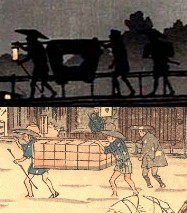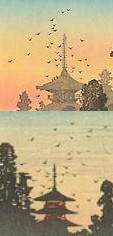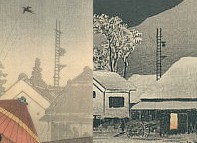On this webpage, in 2002, I originally proposed that the artist known as "Kakei" never existed as a real person, but was a pre-earthquake art name for Takahashi Shōtei. With that interpretation being a new one at the time, I cautiously cataloged prints sealed "Kakei" on this page and kept them out of the Shōtei catalog. As I write this, in January, 2015, the community of shin-hanga scholars and collectors has generally accepted that "Kakei" and Shōtei were indeed the same artist. Recently, I added all of the prints sealed "Kakei" into the Shōtei catalog. To my knowledge, the only previous documentation about the artist Kakei was in the book "The new wave". Discussing Watanabe's publishing business circa 1908, Okamoto Hiromi and Henry D. Smith II wrote (on page 29): "In addition to Shōtei and Sōzan, these early Watanabe productions also bear the seals or signatures of other artists who today remain largely obscure - names such as Shun'yō, Kakei, Fuyō, and Shûrei. Most of these works were in small- and medium-size formats and seem to have often been applied to calendars or Christmas cards". In a footnote, they go on to explain that "Fuyō" was an early name for Narazaki Eisho. Since I was convinced that "Kakei" was an early name for Takahashi Shōtei, I created this page to state my case. | ||||||||||||||||||||||||
|
Catalog:
Prior to adding the pre-earthquake prints sealed "Kakei" to the Shōtei catalog, I had them listed here.
They all had catalog numbers in the format K-xx where xx was a number.
Now that they have been added to the Shōtei catalog, they have lost the "K" prefix and are now categorized and prefixed by format.
If you'd like to see them, follow these steps:
Stylistic Similarities with Shōtei:
Here, from 2002, are my arguments supporting my hypothesis that Kakei and Shōtei were the same person:
It seems clear to me that even the most skeptical observer must acknowledge that there is a common
"feel" between the prints of Kakei and Shōtei.
Here is a display of certain details extracted from Kakei and Shotei prints which tend to reinforce my
theory that they are the same artist.
The upper image to the right is a detail from Shōtei print M-9, Evening glow at Sakawa Bridge.
The lower image is from Kakei print M-142, Village in the Snow.
There is a certain point in the human stride where the trailing foot is about to be raised.
The great majority of the figures in Shōtei's prints are pictured at just that point.
It is interesting to note that Hiroshige also had a tendency to render his figures in the same position.
Kakei prints C-51, S-138, and M-143 also have figures in the same pose.
The upper image to the right is a detail from Shōtei print M-59, Vesper-bells in the village.
The lower image is from Kakei print C-51, Path to Fuji.
I'm thinking that pagoda structures offer lots of nooks and crannies within which birds can nest
or roost. But, when the bells ring, the birds are temporarily disturbed and fly around.
In addition to M-59, Shōtei has captured this moment on prints M-88, C-21, S-3, S-9, and S-14,
in the Shōtei catalog.
The left image is a detail from Shōtei print M-56, Woman returning from a bath.
The right image is from Kakei print M-144, Nihonmatsu.
Japanese towns, with light construction and paper walls, were quite a fire hazard.
In order to catch fires before they might get out of control, many towns had fire lookouts, which
resembled large ladders with platforms attached.
It's unusual for an artist to display these, but Shōtei did. See also the background in print M-80.
Kakei's M-145 (left), Evening at Shinagawa, is the pre-earthquake version of Shōtei's M-6 (right),
with the same title.
It seems very unlikely to me that Shōtei would copy the work of another Watanabe artist with whom he had
worked and attribute the post-earthquake version to himself.
It is much more likely that there was no "other" artist.
For more information about pre- and post-earthquake Shōtei prints, be sure to see the
Variant Shotei Print Designs page.
Here is another example, Nihonmatsu, with Kakei's M-144 on the left and Shōtei's M-107 on the right.
| ||||||||||||||||||||||||

 The Stride:
The Stride:
 Pagoda Birds:
Pagoda Birds:
 Fire Lookout:
Fire Lookout:
 Same Image; Pre- and Post-Earthquake Versions:
Same Image; Pre- and Post-Earthquake Versions:
